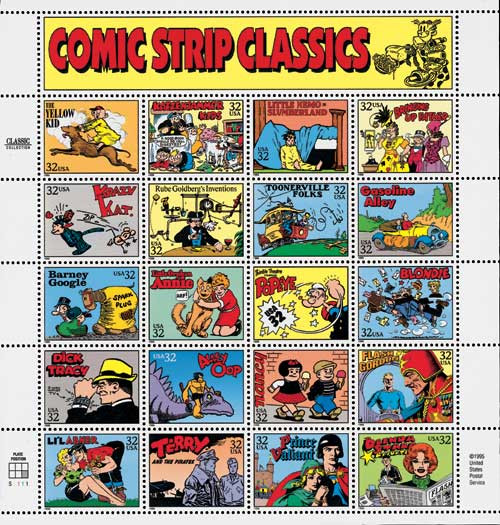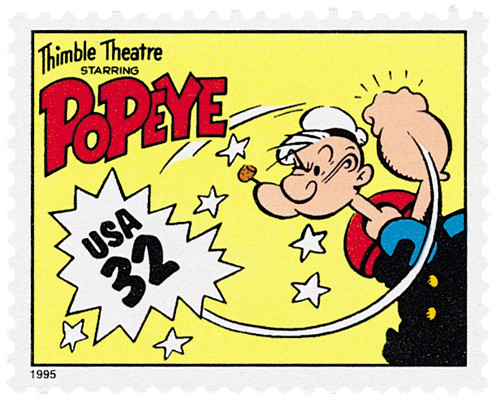
# 3000s - 1995 32c Comic Strip Classics: Prince Valiant
U.S. #3000s
1995 32¢ Prince Valiant
Comic Strip Classics
- Third sheet in the Classic Collection Series
Stamp Category: Commemorative
Set: Comic Strip Classics
Value: 32¢, rate for first-class mail
First Day of Issue: October 1, 1995
First Day Cities: Boca Raton, Florida
Quantity Issued: 300,000,000
Printed by: Stamp Venturers
Printing Method: Photogravure
Format: Panes of 20 in sheets of 120
Perforations: 10.1 x 10.2
Why the stamps were issued: The Comic Strip Classics sheet was the third issue in the Classic Collection Series. There was push to create a stamp to honor American comics as early as the 1960’s, but didn’t get real consideration until 1993. With the 100th anniversary of the comic The Yellow Kid, a comic committee, and an 83-page proposal the USPS finally agreed.
About the stamp designs: Even though only one stamp was approved, Terrence McCaffrey, head of stamp design, thought there was no way to honor American Comics with one single stamp. Therefore, he had a list of all proposed stamps and had Carl Herrman, art director, mock up a sheet of 20 stamps. McCaffrey wanted all the stamps to be taken from original panels by their respected artist. Herrmann worked on going through thousands of panels to find comics of the 20 chosen that showed the central theme of the comic in one panel with clean lines. Then with the help of American Color, that colorizes most of the comics in American newspapers, he was able to colorize them with accurate color choices, even those that were outdated.
Prince Valiant (#3000s) – Carl Herrman used two panels to achieve the right design for this stamp. He wanted Prince Valiant’s features to be seen and not hidden under a helmet like his first idea. The banner on the comics that say “In the days of King Arthur,” Herrman wanted to include, but it the words were lost when shrunk to stamp size, so it was left off.
About the printing process: In order to include the text on the back of each stamp, it had to be printed under the gum, so that it would still be visible if a stamp was soaked off an envelope. Because people would need to lick the stamps, the ink had to be approved by the Food and Drug Administration as non-toxic. The printer also used an extra-fine 300-line screen, which resulted in some of the highest-quality gravure stamp printings in recent years.
History the stamps represent:
Prince Valiant
This comic was the last major strip to be created as a full-page, full-color feature. Set in medieval Britain during the days of King Arthur, this centuries-long saga combined legend, realism, and fantasy. Carefully researched details in battle scenes, as well as domestic settings made the strip seem authentic, if not almost documentary.
Born in Halifax, Nova Scotia, an ambitious young Harold “Hal” Foster bicycled his way to Chicago, to the Art Institute, national Academy of Design, and Chicago Academy of Fine Arts. In 1929, he left a promising career as an advertising illustrator to draw a newspaper adaption of Tarzan of the Apes. After eight years, he left to create his epic strip Prince Valiant.
A meticulous worker who devoted a great deal of time to research, Foster spent as many hours working on his Sunday page (the comic did not appear daily) as any nine-to-five employee. Often, his originals took a week to draw and were upwards of 40 inches tall – the result was a product that won him acclaim from both peers and the general public.
U.S. #3000s
1995 32¢ Prince Valiant
Comic Strip Classics
- Third sheet in the Classic Collection Series
Stamp Category: Commemorative
Set: Comic Strip Classics
Value: 32¢, rate for first-class mail
First Day of Issue: October 1, 1995
First Day Cities: Boca Raton, Florida
Quantity Issued: 300,000,000
Printed by: Stamp Venturers
Printing Method: Photogravure
Format: Panes of 20 in sheets of 120
Perforations: 10.1 x 10.2
Why the stamps were issued: The Comic Strip Classics sheet was the third issue in the Classic Collection Series. There was push to create a stamp to honor American comics as early as the 1960’s, but didn’t get real consideration until 1993. With the 100th anniversary of the comic The Yellow Kid, a comic committee, and an 83-page proposal the USPS finally agreed.
About the stamp designs: Even though only one stamp was approved, Terrence McCaffrey, head of stamp design, thought there was no way to honor American Comics with one single stamp. Therefore, he had a list of all proposed stamps and had Carl Herrman, art director, mock up a sheet of 20 stamps. McCaffrey wanted all the stamps to be taken from original panels by their respected artist. Herrmann worked on going through thousands of panels to find comics of the 20 chosen that showed the central theme of the comic in one panel with clean lines. Then with the help of American Color, that colorizes most of the comics in American newspapers, he was able to colorize them with accurate color choices, even those that were outdated.
Prince Valiant (#3000s) – Carl Herrman used two panels to achieve the right design for this stamp. He wanted Prince Valiant’s features to be seen and not hidden under a helmet like his first idea. The banner on the comics that say “In the days of King Arthur,” Herrman wanted to include, but it the words were lost when shrunk to stamp size, so it was left off.
About the printing process: In order to include the text on the back of each stamp, it had to be printed under the gum, so that it would still be visible if a stamp was soaked off an envelope. Because people would need to lick the stamps, the ink had to be approved by the Food and Drug Administration as non-toxic. The printer also used an extra-fine 300-line screen, which resulted in some of the highest-quality gravure stamp printings in recent years.
History the stamps represent:
Prince Valiant
This comic was the last major strip to be created as a full-page, full-color feature. Set in medieval Britain during the days of King Arthur, this centuries-long saga combined legend, realism, and fantasy. Carefully researched details in battle scenes, as well as domestic settings made the strip seem authentic, if not almost documentary.
Born in Halifax, Nova Scotia, an ambitious young Harold “Hal” Foster bicycled his way to Chicago, to the Art Institute, national Academy of Design, and Chicago Academy of Fine Arts. In 1929, he left a promising career as an advertising illustrator to draw a newspaper adaption of Tarzan of the Apes. After eight years, he left to create his epic strip Prince Valiant.
A meticulous worker who devoted a great deal of time to research, Foster spent as many hours working on his Sunday page (the comic did not appear daily) as any nine-to-five employee. Often, his originals took a week to draw and were upwards of 40 inches tall – the result was a product that won him acclaim from both peers and the general public.












